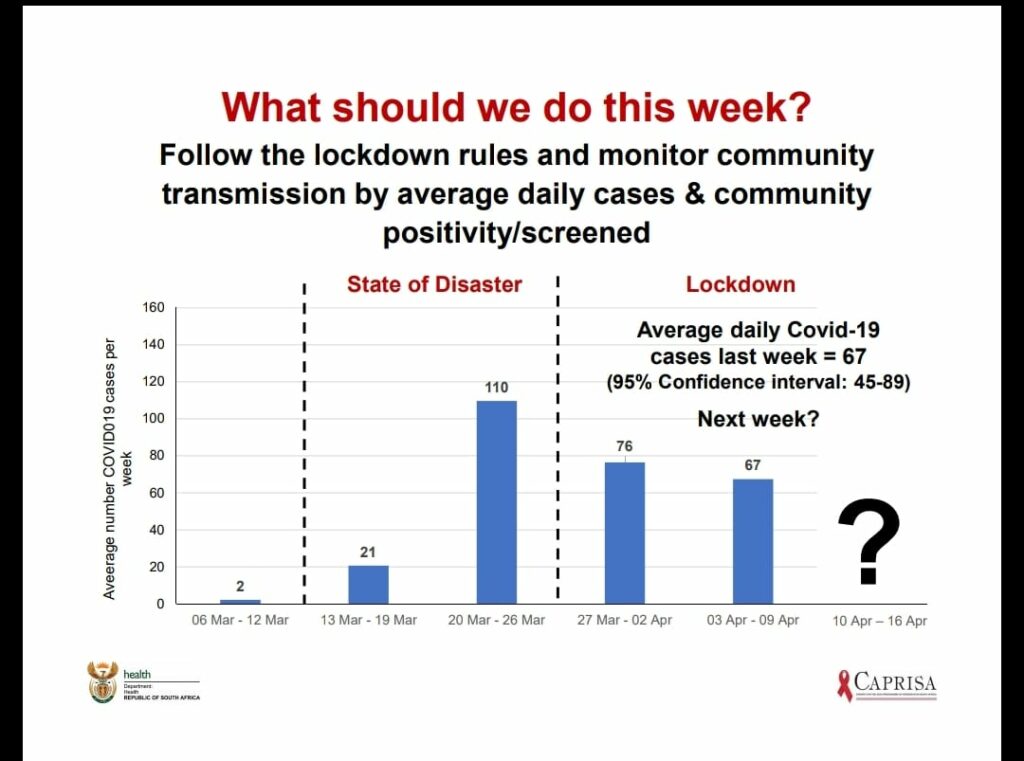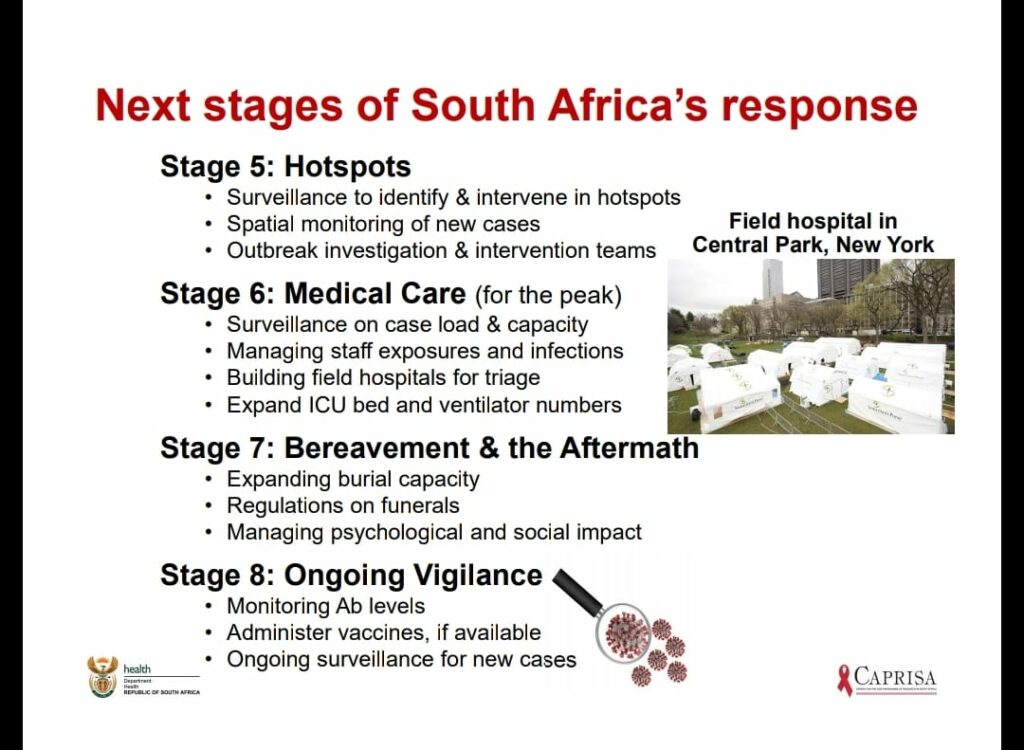A stand in patient is taken into the hospital during Military exercise between Rome and Milan at the infectious diseases department of the Luigi Sacco hospital in Milan, Italy. (Fabrizio Villa /Getty Images).
The darkest days of Covid-19 are still to hit South Africa. But, for now, the national lockdown, disaster declaration and border closures have bought the country some time and given South Africa a “unique” trajectory for the virus.
That time means the government can better prepare the healthcare system for a disease that has so far infected nearly two-million people and killed 120 000 people globally.
This is according to Professor Salim Abdool Karim, the chair of the ministerial advisory group on Covid-19. Together with a group of experts and Health Minister Zwelini Mkhize, last night Karim took the country through the first comprehensive overview of how we are dealing with the disease.
Over the past two weeks, there has been a slight decline in the number of daily cases. During the week before the lockdown, there were 110 daily cases on average. During the first week of lockdown, there were 76 daily cases on average. Last week there were 67 cases on average.
“If you look at our situation, roughly on average one infected person is leading to one new infection. We aren’t seeing a situation where one person leads to many others. And that is exactly because of our interventions,” Karim said.
“That’s why we instituted all these things like social distancing and hand-washing. When you think of a lockdown, it means each infected person is a dead end. We know from that we simply aren’t seeing the growth of the epidemic as we expected.”.
Covid-19 is so dangerous because, in most other countries, each infected person has infected three other people, allowing for rapid, exponential growth. This is called community transmission.
Karim said their projections are that if the number of positive tests is growing between 40 and 90 each day, Covid-19 is nearing a point where it is controlled. If the number of cases, on average across a week, go over that number then initiatives such as the lockdown need to continue.
 Slide 23 of South Africa’s response plan to Covid-19.
Slide 23 of South Africa’s response plan to Covid-19.
If community transmission is low, cases decline. If community transmission is growing, cases will increase and the curve will start to grow exponentially again. This is the central feature the department of health is trying to contain at the moment, by focusing on the greater Johannesburg, Cape Town and the Ethekwini areas as hotspots.
These areas have a lot of infections and they have the potential to spread, because there are so many people with the virus and many communities where it can be transmitted.
Ramping up testing
Professor Kholeka Mlisana from the National Health Laboratory Service reiterated that they would upscale testing and that they have been given enough time to create testing capacity.
[td_block_text_with_title tdc_css=”eyJhbGwiOnsic2hhZG93LXNpemUiOiIyIiwic2hhZG93LWNvbG9yIjoiI2Q4ZDhkOCIsInNoYWRvdy1vZmZzZXQtaCI6IjEiLCJiYWNrZ3JvdW5kLWNvbG9yIjoiI2ZmZmZmZiIsImNvbnRlbnQtaC1hbGlnbiI6ImNvbnRlbnQtaG9yaXotY2VudGVyIiwiZGlzcGxheSI6IiJ9fQ==” f_post_font_size=”16″ f_post_font_family=”fs_7″ f_post_font_spacing=”0.9″ f_post_font_weight=”400″ block_template_id=”td_block_template_8″ border_color=”#e60000″ f_h4_font_transform=”uppercase” f_h4_font_size=”18″ f_h4_font_weight=”400″ f_h4_font_spacing=”0.8″ f_h4_font_family=”420″ custom_title=”Latest” custom_url=”https://mg.co.za/article/2020-03-13-live-the-mgs-guide-to-the-coronavirus-outbreak-in-south-africa/” onclick=”gtag(‘event’, ‘clickCovidticker’, {‘event_category’: ‘covidBlock’, ‘event_label’: ‘rightCovidticker’});”]



Click here for up-to-date information
[/td_block_text_with_title]
“Testing at this time has become critical to ensure that the little fires do not turn into raging fires. We are screening individuals for symptoms and those who have them will be then referred for testing.
“There is capacity that has already been in existence at the National Health Laboratories, where about 30 000 tests per day can be done. Private pathology labs can do about 10 000 to 15 000 tests per day. There are also other institutions, such as research institutes based at medical schools and the CSIR [Council for Scientific and Industrial Research]. We can ramp up to something like 50 000 tests per 24 hours,” said Mlisana.
Planning for the future
Karim said that South Africa’s current trajectory was unique, probably because a disaster was declared so early on. But the likelihood was that the disease would affect far more people, “unless South Africa has a special protective factor, let’s call it the mojo, that’s not present anywhere else in the world our population is at high risk because all of us have no immunity against this virus”.
If fewer people were becoming infected, there was a chance of a controlled easing of the lockdown, he said. But this comes with its own problems. In Japan, for example, an area where the lockdown was eased has seen a dramatic spike in numbers.
“If we let the virus grow unchecked we will see what you see in New York. You will see thousands of people trying to get into a hospital for care. We don’t have enough ventilators, or hospital beds or any of that to care for so many people,” he said.
The government has been putting phases of action into place. Lockdown was the third stage of fighting the virus’s spread. Right now the country is entering stage four, in which there is active case finding and surveillance, which includes door-to-door screening, testing, isolation and contact tracing.
 Slide 25 of South Africa’s response to Covid-19
Slide 25 of South Africa’s response to Covid-19
Karim said that this week lockdown rules must be adhered to and they will monitor daily cases. If we can get to fewer than 44 daily cases on average we can start to ease the lockdown.
“There will be large daily variations. Don’t let that bother you because you have to look at this over a period of time; hence, we are comparing weeks. If we end the lockdown abruptly, we may run the risk of undoing the effort and benefit we have achieved,” he said.
South Africa is unique
Karim said that South Africa has chosen to be proactive and go into communities and find cases instead of waiting, like many other countries did, to confirm the epidemic when people were sick at the hospital doors.
Only South Africa has taken this approach.
“We have more than 28 000 community healthcare workers going house to house in vulnerable communities for screening and testing to find cases,” he said.
Healthcare response during the peak
South Africa has more than two-million people who are HIV positive and are not on antiretrovirals, and about 500 000 of them have a low CD4 count. These people and those who have tuberculosis may have a much more severe case of Covid-19.
Karim warned: “We are going to need to make sure that we are preparing for a possible additional burden from those individuals. Plus, on top of everything else we are going to have our Covid epidemic at the same time as our annual flu epidemic. We are going to need to deal with that burden.”
The presentation then focused on protecting the elderly during this time and Karim said that there needs to be serious consideration that people over 60 and 70 years old could have some kind of voluntary partial lockdown until the end of September.
“I don’t know if it will be over by the end of September — I’m not a crystal-ball gazer — but this is a target for now.”
Economic effects
In response to questions about the economic effects of Covid-19, Mkhize said the government was getting data that helped to inform its decisions. He did not go into any details.